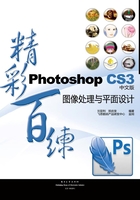
2.3 高级应用制作与赏析
实例15 超酷名车
【A.技术分析】
本实例将绘制一部技术质感超强的名车。方法与绘制其他的物体是一样的,需要注意的是金属质感的表现,即亮部特别亮,暗部特别暗,对比非常强烈等,这些特点就是金属或玻璃质感绘制特点。最终效果如图2-223所示。

图2-223 最终效果
【B.制作步骤】
(1)绘制前首先要有一定的图形概念,前面已经提到过,或是绘制自己想象中的图形,或是在图纸上绘制草稿输入电脑再描绘上色,再将其完整形状制作成半透明的灰度图形,以便让读者便于观察。选择【钢笔工具】 ,新建图层,绘制车门的外形,路径如图2-224所示。
,新建图层,绘制车门的外形,路径如图2-224所示。

图2-224 绘制车门路径
(2)按【Ctrl+Enter】组合键,设置一个介于暗部与高光之间的中间色,在此新建图层,并填充颜色为:土黄色(R:202,G:146,B:32),如图2-225所示。

图2-225 填充车门中间色
(3)选择【钢笔工具】 ,新建图层,绘制车门的主要部分外形,转化为选区后,按【Ctrl+J】组合键复制选区内容到新图层“图层2”,如图2-226所示。
,新建图层,绘制车门的主要部分外形,转化为选区后,按【Ctrl+J】组合键复制选区内容到新图层“图层2”,如图2-226所示。

图2-226 复制车门路径
提示
双击图层面板上的图层名称,可以成为可更改状态,可以命令图层名称为一些特殊的名称,如车门、车灯等,便于辨认和选择。
(4)选择【加深工具】 ,设置属性栏上的【曝光度】为:10%,对车门凹进去的部分反复涂抹进行加深处理,如图2-227所示。
,设置属性栏上的【曝光度】为:10%,对车门凹进去的部分反复涂抹进行加深处理,如图2-227所示。

图2-227 加深处理
(5)选择【减淡工具】 ,设置属性栏上的【曝光度】为:10%,对车门凸出的部分反复涂抹进行减淡处理,此时暗部、中间色与亮部都具备了,所以有了立体感,效果如图2-228所示。
,设置属性栏上的【曝光度】为:10%,对车门凸出的部分反复涂抹进行减淡处理,此时暗部、中间色与亮部都具备了,所以有了立体感,效果如图2-228所示。

图2-228 绘制车门的亮部
(6)选择【钢笔工具】 ,新建图层,绘制车门的高光外形,转化为选区后,填充颜色为白色,如图2-229所示。
,新建图层,绘制车门的高光外形,转化为选区后,填充颜色为白色,如图2-229所示。

图2-229 绘制白色的高光部分
(7)取消选区,选择【橡皮擦工具】 ,设置属性栏上的【不透明度】为:15%,反复擦除高光的边缘部分,如图2-230所示。
,设置属性栏上的【不透明度】为:15%,反复擦除高光的边缘部分,如图2-230所示。

图2-230 擦除白色高光部分
(8)设置该高光图层的【图层】面板上的【不透明度】为:50%,效果如图2-231所示。

图2-231 调整白色高光不透明度
(9)按住【Ctrl】键加选车门的所有图层,并按【Ctrl+E】组合键合并所有图层,然后执行【图像】→【调整】→【亮度/对比度】命令,参数设置如图2-232所示。

图2-232 调整【亮度/对比度】参数
(10)此时,车门的颜色对比度加强,效果如图2-233所示。

图2-233 车门的颜色对比度加强
(11)执行【图像】→【调整】→【色阶】命令,调整滑块,如图2-234所示。

图2-234 调整【色阶】参数
(12)此时,车门的亮度/对比度更加加强,颜色也更为鲜艳,整体的金属质感加强,如图2-235所示。

图2-235 车门的亮度/对比度加强
(13)仿照以上的绘制流程制作车门的其余部分,如车门的厚度等,如图2-236所示。

图2-236 绘制车门的其余部分
(14)事实上,车的整体效果也是这样绘制的。方法并不难,主要是考验大家的耐心。首先绘制车身的外轮廓,然后填充一个车身的中间色,如图2-237所示。接着我们绘制其余的部分,如车轮、车灯、车座、车玻璃等。

图2-237 车身中间色
(15)然后对车身进行加深减淡处理,必要的时候可以通过辅助工具如画笔工具、钢笔工具等进行绘制,如图2-238所示。

图2-238 绘制车身的细节
(16)用同样的方法绘制后车轮部分,效果如图2-239所示。

图2-239 绘制后车轮
(17)用同样的方法绘制前车轮部分,效果如图2-240所示。

图2-240 绘制前车轮
(18)用同样的方法绘制车头部分,效果如图2-241所示。

图2-241 绘制车头
(19)用同样的方法绘制车灯部分,效果如图2-242所示。

图2-242 绘制车灯
(20)用同样的方法绘制另一车灯部分,效果如图2-243所示。

图2-43 绘制另一个车灯
(21)绘制路径填充颜色到车门,效果如图2-244所示。

图2-244 填充颜色到车门
(22)用同样的方法加深减淡处理车灯部分,效果如图2-245所示。

图2-245 加深减淡处理车灯部分
(23)最后加上车座、投影等细节,最终效果如图2-246所示。

图2-246 最终效果
【C.拓展知识——转换路径为选区的方法】
通常情况下,我们都会采用按【Ctrl+Enter】组合键的方法将路径转化为选区,在此介绍另一种将路径转化为选区的方法。
绘制一个完整的路径后 ,选择【路径】面板,单击其下方的【将路径作为选区载入】按钮
,选择【路径】面板,单击其下方的【将路径作为选区载入】按钮
 ,即可将路径转化为选区
,即可将路径转化为选区 ,如图2-247所示。
,如图2-247所示。

图2-247 转换路径为选区
实例16 时尚名表
【A.技术分析】
本实例将绘制一块时尚名表。绘制手表的关键是金属质感的表现,而本例在绘制手表时的特点在于,如何绘制矩形块面的手表金属带,另外还要介绍如何绘制表面的圆形金属面。最终效果如图2-248所示。

图2-248 最终效果
【B.制作步骤】
(1)选择【矩形选框工具】 ,绘制矩形选区,并填充颜色为:浅灰色(R:206,G:206,B:206),如图2-249所示。
,绘制矩形选区,并填充颜色为:浅灰色(R:206,G:206,B:206),如图2-249所示。

图2-249 绘制灰色矩形
(2)选择属性栏上的【从选区减去】按钮 ,框选减去部分选区,如图2-250所示。
,框选减去部分选区,如图2-250所示。

图2-250 减去部分选区
(3)执行【选择】→【修改】→【羽化】命令,设置对话框中的参数为:2像素,选择【加深工具】 ,设置属性栏上的【曝光度】参数为:10%,在选区范围内进行反复涂抹,如图2-251所示。
,设置属性栏上的【曝光度】参数为:10%,在选区范围内进行反复涂抹,如图2-251所示。

图2-251 涂抹表带的转折面
(4)选择【矩形选框工具】 ,将该选区移动到暗部的上方,并选择【减淡工具】
,将该选区移动到暗部的上方,并选择【减淡工具】 ,涂抹亮部,效果如图2-252所示。
,涂抹亮部,效果如图2-252所示。

图2-252 涂抹亮部
提示
此时的表带块面有一个黑色和白色的对比,该部分就有转角的过渡感。
(5)按【Ctrl】键不放,单击矩形所在图层的缩览框,载入选区。选择【加深工具】在选区上方的边缘进行涂抹,加深效果如图2-253所示。

图2-253 涂抹另一边的暗部
(6)此时执行【图像】→【调整】→【亮度/对比度】命令,设置参数为:15,25。此时的表带效果金属质感更为强烈。用同样的方法绘制其余的表带即可,如图2-254所示。

图2-254 绘制其余的表带
(7)合并所有的表带并复制旋转到正对面,如图2-255所示。

图2-255 合并并复制表带
(8)接着选择【椭圆选框工具】 ,按住【Alt+Shift】键从中心向四周绘制正圆选区。选择工具【渐变工具】
,按住【Alt+Shift】键从中心向四周绘制正圆选区。选择工具【渐变工具】 ,设置其渐变色为:白色-灰色-白色的渐变,如图2-256所示。
,设置其渐变色为:白色-灰色-白色的渐变,如图2-256所示。

图2-256 设置渐变色
(9)新建图层,选择属性栏上的【角度渐变】按钮 ,从中心向斜向拖动。复制该图层,并按【Ctrl+T】组合键打开自由变换调节框,选择【水平翻转】命令,如图2-257所示。
,从中心向斜向拖动。复制该图层,并按【Ctrl+T】组合键打开自由变换调节框,选择【水平翻转】命令,如图2-257所示。

图2-257 绘制锥形选区并复制翻转
(10)复制该图层,并按住【Shift】键,拖动角点,等比例缩放,效果如图2-258所示。

图2-258 等比例缩放
(11)执行【选择】→【变换选区】命令,等比例缩放选区到一定的程度后,新建图层,填充颜色为黑色,如图2-259所示。

图2-259 绘制黑色表面
(12)运用以上介绍的方法绘制其余的表带部分和表面部分,最终效果如图2-260所示。

图2-260 最终效果
【C.拓展知识——选区的加选和减选】
加选、减选、交叉选区范围都是很巧妙的选择范围工具。如果绘制圆柱,就需要巧妙地使用加选工具。而锥形则需要巧妙使用减选工具。
(1)绘制矩形,然后加选椭圆选区,最后填充颜色,再增加一个椭圆顶面即可,如图2-261所示。

图2-261 绘制圆柱体
(2)绘制矩形填充渐变色,然后【自由变换】命令透视变形。取消选区后绘制椭圆,加选矩形,反向选区将不需要的部分选中,然后删除选区范围内的内容,形成锥形效果如图2-262所示。

图2-262 绘制锥形体
实例17 可爱的青蛙
【A.技术分析】
本实例将绘制可爱的青蛙,绘制青蛙表面的效果与绘制玫瑰枝杈是一样的绘制方法。表面上加入一些黄色的效果,添加一些杂色,更贴近青蛙的本色。最终效果如图2-263所示。

图2-263 最终效果
【B.制作步骤】
(1)选择【钢笔工具】 ,绘制青蛙的头部,并转化为选区,填充颜色为:浅绿色(R:166,G:148,B:2),如图2-264所示。
,绘制青蛙的头部,并转化为选区,填充颜色为:浅绿色(R:166,G:148,B:2),如图2-264所示。

图2-264 绘制青蛙头部
(2)选择【加深工具】 或【减淡工具】
或【减淡工具】 绘制青蛙表面的凹凸效果,凹进去的部分采用加深处理,突出的部分采用减淡处理,如图2-265所示。
绘制青蛙表面的凹凸效果,凹进去的部分采用加深处理,突出的部分采用减淡处理,如图2-265所示。

图2-265 加深或减淡处理青蛙凹凸
(3)选择【画笔工具】 ,设置前景色为:橘黄色(R:224,G:176,B:0)。设置属性栏上的【不透明度】为:10%,新建图层,反复涂抹,效果如图2-266所示。
,设置前景色为:橘黄色(R:224,G:176,B:0)。设置属性栏上的【不透明度】为:10%,新建图层,反复涂抹,效果如图2-266所示。

图2-266 绘制橘黄色画笔
(4)执行【滤镜】→【杂色】→【添加杂色】命令,设置参数为:10,效果如图2-267所示。

图2-267 添加杂色
(5)设置【图层混合模式】为:柔光,效果如图2-268所示。

图2-268 设置柔光效果
(6)不断地加强或减淡各凹凸效果,其中眼睛部分用圆形黑色蒙住,效果如图2-269所示。

图2-269 加强眼睛凹凸效果
(7)采用以上介绍的方法绘制眼睛、肚子、腿及叶子等,绘制左眼的颜色以红色为主。当然,你也可以绘制成以绿色或蓝色为主的个性化色彩。效果如图2-270所示。

图2-270 绘制左眼
(8)绘制另一只眼睛,如图2-271所示。

图2-271 绘制右眼
(9)绘制青蛙的肚子部分,效果如图2-272所示。

图2-272 绘制青蛙肚子
(10)绘制青蛙的腿部分,效果如图2-273所示。

图2-273 绘制青蛙腿
(11)绘制青蛙的背景或找一张绿色树叶的素材作为背景,最终效果如图2-274所示。

图2-274 最终效果
【C.拓展知识——杂色命令】
【杂色】命令制作质感效果,还可以运用到鸡蛋壳及毛皮的表现等。值得一提的是,“杂色”对话框有一个复选框为【单色】的选项。如果没有选项,杂色的表现为彩色的随机杂点效果。选择与未选【单色】选项的效果,如图2-275和2-276所示。

图2-275 选择【单色】选项

图2-276 未选择【单色】选项
实例18 憨态的熊猫
【A.技术分析】
本实例将绘制一只憨态可拘的大熊猫,制作本实例的目的是,希望提示读者学会绘制动物的毛发。其中使用到【杂色】命令,之后使用【涂抹工具】涂抹出毛发的效果。最终效果如图2-277所示。

图2-277 最终效果
【B.制作步骤】
(1)选择【钢笔工具】 ,绘制熊猫的头部,并转化为选区,新建图层并填充颜色为:粉黄色(R:254,G:232,B:182),如图2-278所示。
,绘制熊猫的头部,并转化为选区,新建图层并填充颜色为:粉黄色(R:254,G:232,B:182),如图2-278所示。

图2-278 绘制熊猫的头部
(2)选择【加深工具】 或【减淡工具】
或【减淡工具】 绘制熊猫面部的肌肉凹凸的效果,凹进去的部分采用加深处理,突出的部分采用减淡处理。这些与前面的方法一致,如图2-279所示。
绘制熊猫面部的肌肉凹凸的效果,凹进去的部分采用加深处理,突出的部分采用减淡处理。这些与前面的方法一致,如图2-279所示。

图2-279 加深或减淡处理面部肌肉
(3)添加【单色】杂色,效果如图2-280所示。

图2-280 添加杂色效果
(4)选择【涂抹工具】 ,设置属性栏上的【曝光度】为:20,而画笔样式设置为【干画笔】,沿边缘进行短距离的涂抹,如图2-281所示。
,设置属性栏上的【曝光度】为:20,而画笔样式设置为【干画笔】,沿边缘进行短距离的涂抹,如图2-281所示。

图2-281 涂抹熊猫边缘的毛发
(5)内部也用同样的方法进行涂抹,绘制出毛融融的效果,选择【加深工具】 对局部进行颜色上的加强,如图2-282所示。
对局部进行颜色上的加强,如图2-282所示。

图2-282 绘制内部毛发
(6)至于其余部分的绘制,前面已经讲解了很多,大家应当自行尝试绘制。这里主要提供毛发的制作方法,最终效果如图2-283所示。

图2-283 最终效果
【C.拓展知识——自定画笔样式】
在绘制熊猫的过程中也许你会很苦恼,认为没有合适的画笔样式可以帮助快速绘制一些长毛或短毛、硬毛或软毛。在此提供一种自定义画笔的方法,以便解决将来绘制其他毛发类的苦恼。
(1)首先绘制自己所需要的图案于一个文件窗口中,该文件的长宽最好控制在2到3厘米以内,分辨率为:72像素,且背景为:透明。“新建“对话框如图2-284所示。

图2-284 设置“新建”对话框
(2)绘制自己需要的画笔样式,如图2-285所示。

图2-285 绘制新画笔样式
(3)如果有几个图层在一起,便合并所有的图层于一个图层中,如图2-286所示。

图2-286 合并图层于一层
(4)执行【编辑】→【自定画笔预设】命令,打开“画笔名称”对话框,取自己便于辨认的画笔名称,如图2-287所示。

图2-287 设置“画笔名称”对话框
(5)确定后,该画笔样式位于画笔面板上最后一个按钮,如图2-288所示。

图2-288 新样式位于预设的最后一位
(6)新建文件窗口,随意绘制感受自定义画笔的效果,如图2-289所示。

图2-289 随意绘制
实例19 灵动美女
【A.技术分析】
本实例将绘制一位梦幻中的美少女。前面的实例已经讲解了很多关于加深减淡处理的效果,而绘制该美女的面部大多采用此方法,所以在此重点介绍眼睛是如何绘制的,让读者深入体会制作有神眼睛的绘制方法。最终效果如图2-290所示。

图2-290 最终效果
【B.制作步骤】
(1)运用之前实例所提供的方法绘制美少女,如图2-291所示。

图2-291 绘制人物的整体效果
(2)选择【钢笔工具】 绘制眼睛的大体形状,并确定眼睛与眉毛和鼻梁之间的位置。然后用【模糊工具】
绘制眼睛的大体形状,并确定眼睛与眉毛和鼻梁之间的位置。然后用【模糊工具】 ,处理其边缘,如图2-292所示。
,处理其边缘,如图2-292所示。

图2-292 绘制眼睛的大形
提示
尽量每画一个步骤新建一个图层,这样便于修改。只有最后达到自己满意状态后,才合并所有的图层,因为合并图层后的文件所占存储空间就不大了。
(3)新建图层并绘制一些暗红色画笔于眼角,然后选择【涂抹工具】 对眼睫毛后端进行长度的修饰。而采用【加深工具】
对眼睫毛后端进行长度的修饰。而采用【加深工具】 或【减淡工具】
或【减淡工具】 对眼角修饰出凹凸效果,如图2-293所示。
对眼角修饰出凹凸效果,如图2-293所示。

图2-293 绘制眼角
(4)选择【钢笔工具】 绘制眼白的大体形状,并填充颜色为:粉红色,如图2-294所示。
绘制眼白的大体形状,并填充颜色为:粉红色,如图2-294所示。

图2-294 绘制眼白
(5)选择【加深工具】 或【减淡工具】
或【减淡工具】 对其进行修饰,如图2-295所示。
对其进行修饰,如图2-295所示。

图2-295 修饰眼白
(6)选择【钢笔工具】 绘制黑眼珠的大体形状,并填充颜色为:黑色,对其边缘修饰轻微的模糊程度,如图2-296所示。
绘制黑眼珠的大体形状,并填充颜色为:黑色,对其边缘修饰轻微的模糊程度,如图2-296所示。

图2-296 绘制眼珠
(7)绘制暗红色的点在眼珠上,用【涂抹工具】 向四周涂抹,形成放射状,选择【加深工具】
向四周涂抹,形成放射状,选择【加深工具】 或【减淡工具】
或【减淡工具】 对其进行修饰,如图2-297所示。
对其进行修饰,如图2-297所示。

图2-297 修饰眼珠质感
(8)选择【钢笔工具】 绘制瞳孔的大体形状,并填充颜色为:黑色,对其边缘修饰轻微的模糊程度,如图2-298所示。
绘制瞳孔的大体形状,并填充颜色为:黑色,对其边缘修饰轻微的模糊程度,如图2-298所示。

图2-298 绘制瞳孔
(9)设置前景色为:白色,选择【画笔工具】 绘制高光部分,配合属性栏上的【不透明度】绘制相对暗一些的白色作为高光点的衬托。效果如图2-299所示。
绘制高光部分,配合属性栏上的【不透明度】绘制相对暗一些的白色作为高光点的衬托。效果如图2-299所示。

图2-299 绘制高光
(10)最后绘制双眼皮等作为装饰效果。当然,如果喜欢还可以做一些颜色上的调整,或根据自己的喜好加强眼睫毛的长度、密度等。修饰细节,效果如图2-300所示。

图2-300 修饰细节
【C.拓展知识——模糊工具】
在本实例的绘制过程中,我们使用到【模糊工具】 ,该工具在图形上进行涂抹可以在涂抹之处产生模糊效果。其模糊程度与属性栏上的【强度】参数息息相关,即该参数越大,模糊程度越大,反之越小。
,该工具在图形上进行涂抹可以在涂抹之处产生模糊效果。其模糊程度与属性栏上的【强度】参数息息相关,即该参数越大,模糊程度越大,反之越小。
另外,该工具与【滤镜】命令中的【高斯模糊】是有区别的。通过命令制作模糊效果是针对选区范围内而制作的,并且最好配合【羽化】命令进行。而工具是实时实现模糊效果只针对鼠标经过的区域。将二者处理效果对比,如图2-301和2-302所示。

图2-301 工具模糊

图2-302 命令模糊
实例20 惊讶的少女
【A.技术分析】
本实例将绘制一位吃惊的少女。其中,面部表情都是大块面,所以不是特别困难。但要提示一点的是,不是每一种毛发都用涂抹工具进行制作。在此就选用钢笔工具,最后效果如图2-303所示。

图2-303 最终效果
【B.制作步骤】
(1)使用【钢笔工具】 绘制各大块面部分并填充上和谐的颜色,如图2-304所示。
绘制各大块面部分并填充上和谐的颜色,如图2-304所示。

图2-304 大块面颜色
(2)选择【钢笔工具】 绘制头发丝路径,如图2-305所示。
绘制头发丝路径,如图2-305所示。

图2-305 绘制头发丝
(3)按【Ctrl+Enter】组合键将路径转化为选区,并填充颜色为白色,如图2-306所示。

图2-306 为头发丝填充颜色
(4)选择【钢笔工具】 绘制形态各异的头发丝路径,如图2-307所示。
绘制形态各异的头发丝路径,如图2-307所示。

图2-307 绘制形态各异的头发丝
(5)按【Ctrl+Enter】组合键将路径转化为选区,并填充颜色为白色,如图2-308所示。

图2-308 为其他头发丝填充颜色
(6)选择【钢笔工具】 绘制其他形态各异的头发丝路径,并填充为:白色,形成风吹效果,如图2-309所示。
绘制其他形态各异的头发丝路径,并填充为:白色,形成风吹效果,如图2-309所示。

图2-309 最终效果
【C.拓展知识——自由钢笔工具】
在本实例的绘制过程中,我们多次使用到【钢笔工具】 。但事实上,在钢笔工具组中还有其他的一些钢笔工具,如【自由钢笔工具】
。但事实上,在钢笔工具组中还有其他的一些钢笔工具,如【自由钢笔工具】 ,该工具可以按住鼠标不放,像使用铅笔一样随意在画面中绘制任意线条。但是也可以配合属性栏上的【磁性的】复选框,选择图片中的人物或花卉等界限图案。该工具有一个磁性跟踪功能,它能够辨认相似的像素,尤其对边界分明的图片进行快速选择的功能更强大。
,该工具可以按住鼠标不放,像使用铅笔一样随意在画面中绘制任意线条。但是也可以配合属性栏上的【磁性的】复选框,选择图片中的人物或花卉等界限图案。该工具有一个磁性跟踪功能,它能够辨认相似的像素,尤其对边界分明的图片进行快速选择的功能更强大。
比如,在花卉的边界处单击一个像素点,然后放开鼠标键跟随边缘移动,即可自动形成跟踪路径,如图2-310所示。

图2-310 自由钢笔工具追踪路径